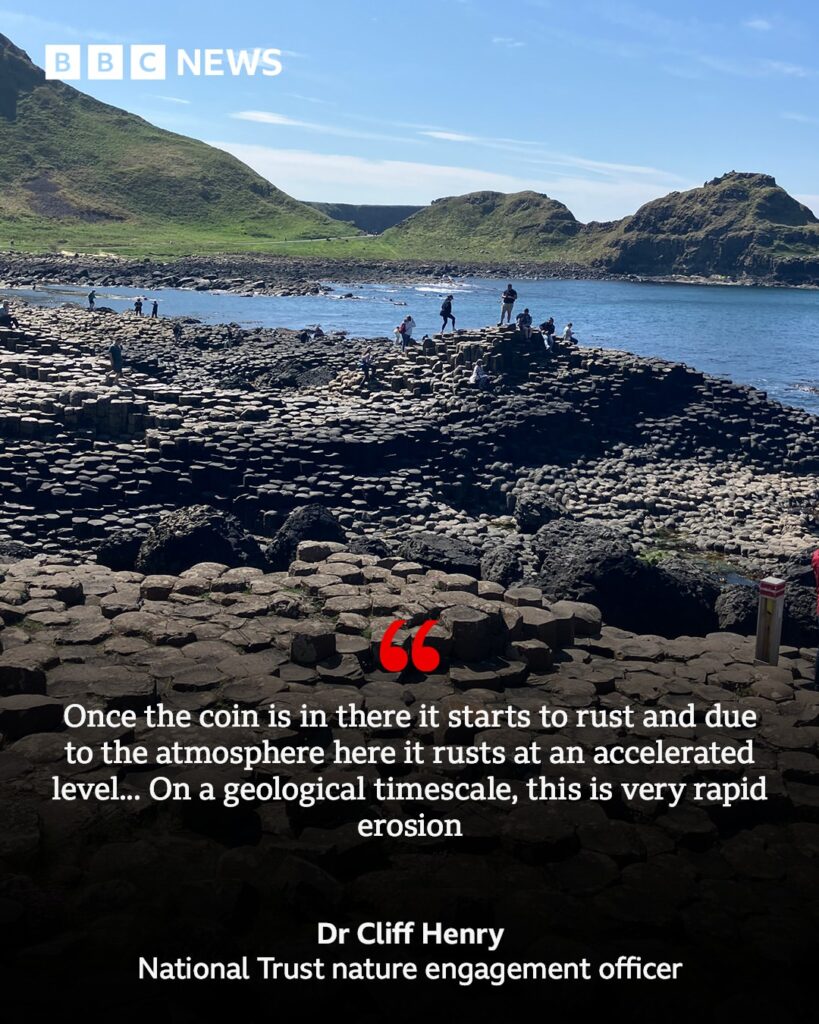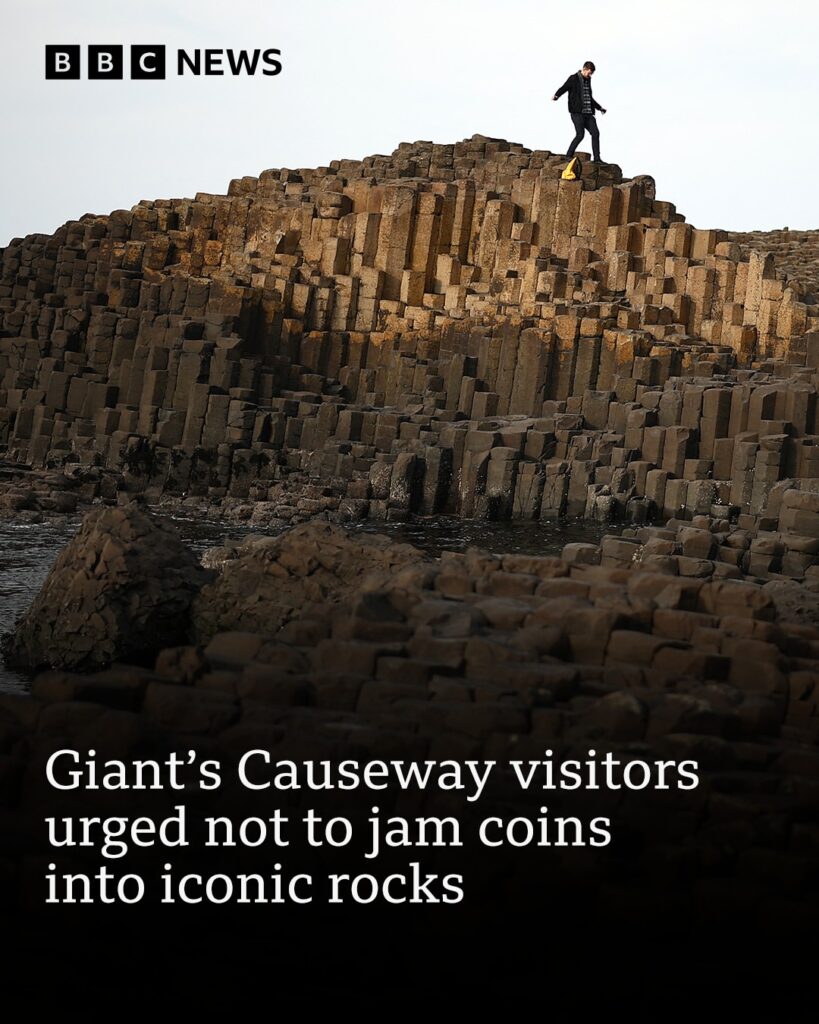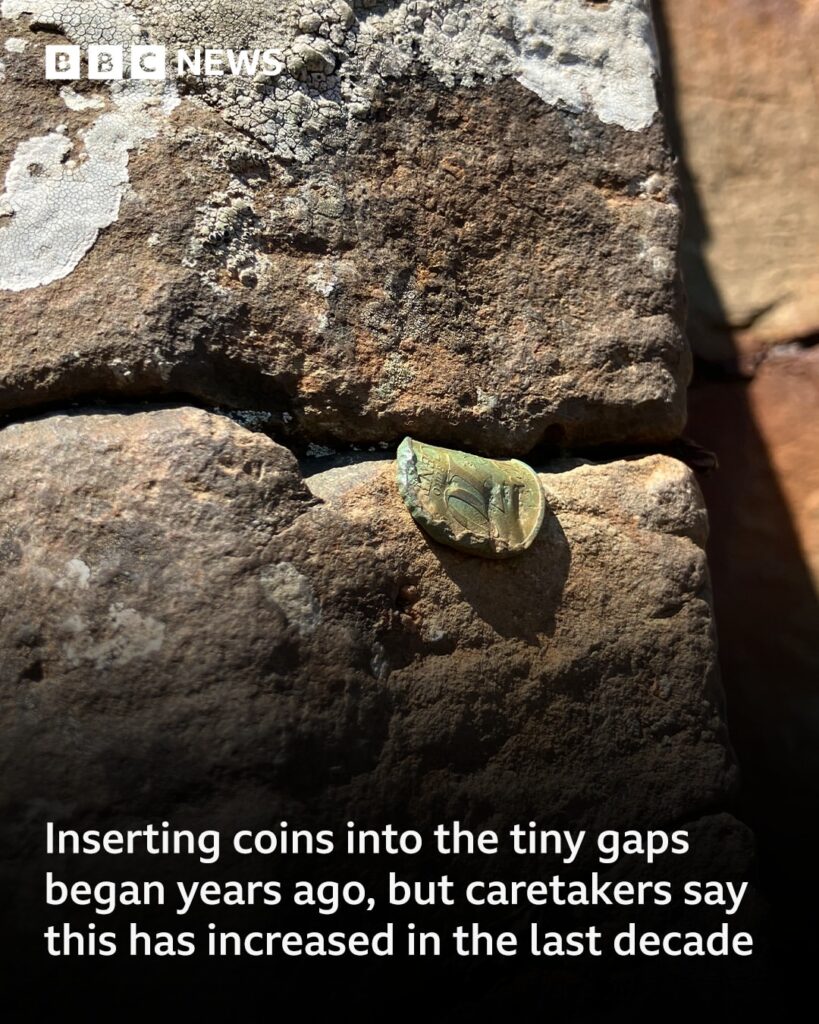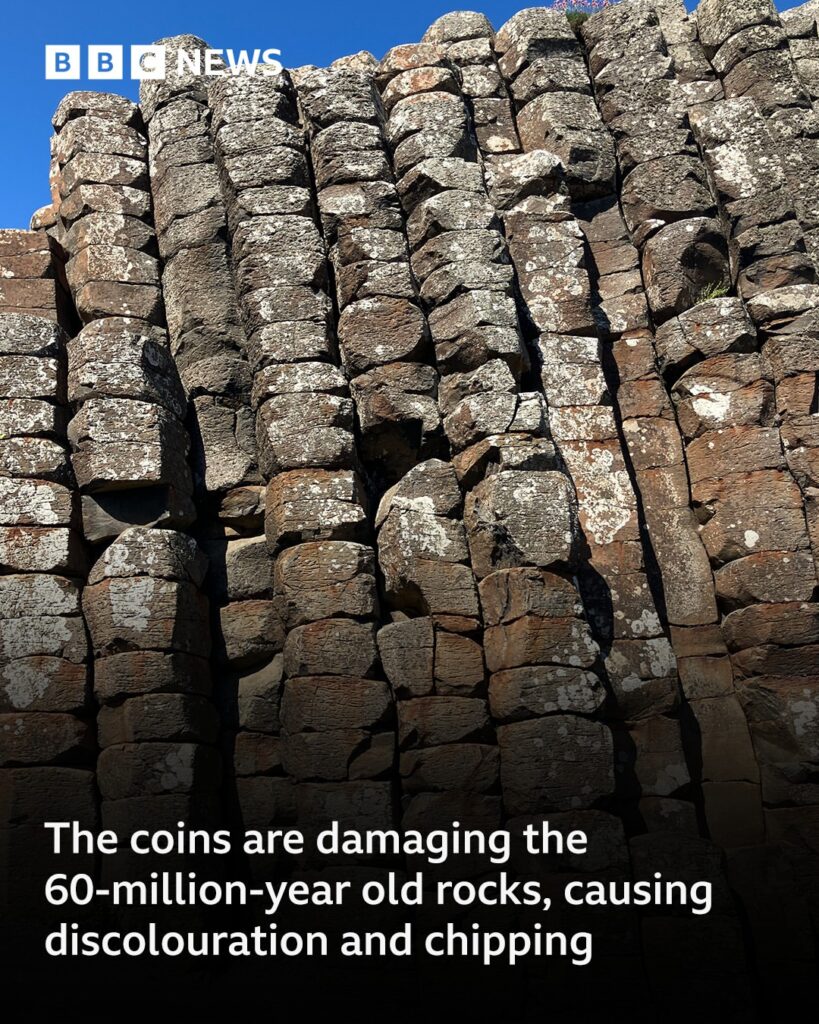
But now, there’s a problem caused by coins.
Over many years visitors have inserted coins into the tiny gaps between the rocks at one of Northern Ireland’s most famous beauty spots.
They are having a direct impact on the rocks themselves and the worst affected are the basalt columns, that make up The Loom – the iconic 10 feet high leaning towers of rock.
The National Trust said not only is it Northern Ireland’s most valuable natural phenomenon, it is important for the economy too.
Tap the link in @BBCNews‘s bio to find out what is being done about it.
(📷 Getty Images, BBC)
The Giant’s Causeway, a UNESCO World Heritage Site and one of Northern Ireland’s most iconic natural wonders, has long captured the imagination of people around the world. With its roughly 40,000 interlocking basalt columns formed by volcanic activity some 60 million years ago, the site draws nearly a million visitors annually. Yet despite its majestic appearance and global fame, the Giant’s Causeway faces a variety of threats—both mythical and real—that have challenged its survival across the ages.
From ancient legends of battling giants to the modern realities of climate change, the story of the Giant’s Causeway is not just one of geological marvel, but also one of resilience.
Legends of Giants: The Mythical Threat

The name “Giant’s Causeway” stems from one of the most enduring and beloved legends in Irish folklore. According to myth, the causeway was built by the giant Fionn mac Cumhaill (or Finn McCool), who created the stone path across the sea to challenge a Scottish rival, Benandonner. The tale goes that Fionn tore up great chunks of the Antrim coast and hurled them into the sea to create the pathway. When Benandonner came across, Fionn’s wife disguised him as a baby, leading Benandonner to believe the Irish giant must be enormous if his “child” was so big. In fright, he fled back to Scotland, destroying the causeway behind him.
These legends have added a rich cultural layer to the site, transforming it from a geological curiosity into a symbol of Irish identity and myth. While the giants of folklore may no longer pose a threat, the story underscores the way people have long tried to understand and explain natural wonders—and how those stories help shape their preservation.
The Scientific Reality: Erosion and Environmental Pressure
In geological terms, the Giant’s Causeway is a product of intense volcanic activity during the Paleogene period. Lava cooled rapidly, cracking into the iconic hexagonal columns we see today. This remarkable formation is, however, not immune to natural degradation.
Coastal erosion is perhaps the most immediate and visible threat. The wild Atlantic constantly pounds the rocks, slowly wearing them down. While this is a natural process, the sheer volume of visitors climbing on the stones—despite efforts to limit damage—has accelerated wear on certain areas. The National Trust, which manages the site, has installed pathways and observation points to help protect the stones, but the challenge remains.
More worrying still is the long-term threat posed by climate change. Rising sea levels and increasingly frequent storm surges pose a direct risk to coastal areas like the Causeway. The UK Climate Impacts Programme has identified coastal heritage sites as particularly vulnerable, and projections suggest that without intervention, sea level rise could reshape the landscape significantly in the next century.
“Even a small increase in sea level can have dramatic effects on wave energy and erosion patterns,” says Dr. Aoife Bradley, a coastal geologist at Queen’s University Belfast. “If we continue on our current trajectory, sites like the Giant’s Causeway could see irreversible changes.”
Human Impact: Tourism and Development

Another threat comes not from nature, but from the very people who come to admire it. Tourism has helped bring attention and economic benefit to the region, but it’s also created logistical and environmental strain. Heavy foot traffic, littering, and informal climbing routes contribute to localized damage. Although the National Trust has implemented measures to manage the impact—such as timed tickets, guided tours, and conservation zones—balancing access with protection remains a delicate task.
There have also been concerns about nearby development. In 2012, plans to build a private visitor center close to the site sparked outrage among conservationists and the public. Though eventually halted, the episode highlighted how commercial interests can sometimes conflict with heritage preservation.
“Once a site like this is altered or damaged, it can’t be undone,” notes Fiona Wallace, a campaigner for the Causeway Coastal Protection Group. “We need to treat it with the same respect we would give to a priceless artifact in a museum.”
Preservation Efforts: Science Meets Stewardship

In recent years, a combination of technological innovation and traditional stewardship has been employed to protect the Giant’s Causeway. Drones are used to monitor erosion, high-resolution imaging helps map the condition of the stones, and tide sensors track sea level changes in real time. Conservationists are working closely with climate scientists to model future risks and develop adaptive strategies.
Community engagement has also played a vital role. Local schools, tourism workers, and residents are involved in educational initiatives to foster a sense of shared responsibility for the site’s future. The National Trust’s “Forever for Everyone” campaign emphasizes long-term sustainability and inclusivity, ensuring the site can be enjoyed by future generations.
A Future at the Edge
The Giant’s Causeway stands at the intersection of myth and reality, beauty and fragility. It tells a story that spans millions of years, from the volcanic eruptions that shaped the Earth’s surface to the modern challenges of climate change and conservation.
In a time when natural heritage sites are increasingly at risk—from environmental change, human activity, or neglect—the Causeway reminds us of the delicate balance we must strike. Whether as a marvel of geology, a symbol of legend, or a barometer of our environmental future, the Giant’s Causeway endures. But its survival, now more than ever, depends not on giants, but on us.



